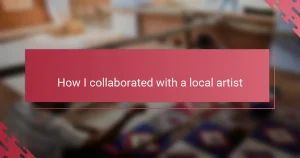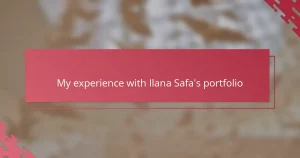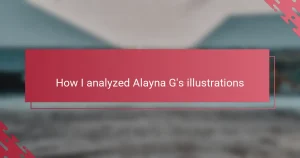Key takeaways
- Traditional media, like charcoal, fosters patience and acceptance of imperfections, adding depth and emotion to artwork.
- Charcoal enhances portfolio art with rich textures and emotional conveyance, making each piece feel alive.
- Choosing the right materials, including paper and blending tools, is crucial for achieving quality charcoal work.
- Integrating charcoal with digital techniques allows for a unique blend of raw texture and vibrant color, enriching the storytelling of the artwork.
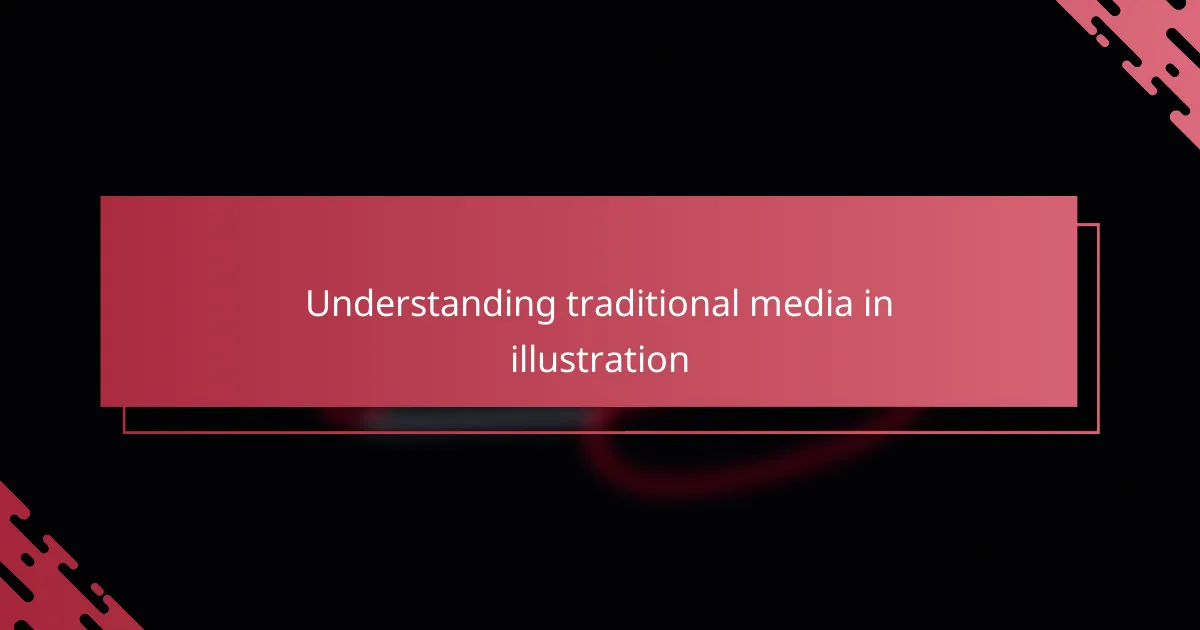
Understanding traditional media in illustration
Traditional media, like charcoal, has a tactile quality that digital tools simply can’t replicate. When I first picked up charcoal, I was amazed by how the texture and pressure could create such raw, expressive lines—it felt like the medium was alive beneath my fingers. Have you ever wondered why some artists stick to paper and pencil despite all the digital advances? For me, it’s the unpredictability and depth that traditional media brings to an illustration.
Working with charcoal taught me a lot about patience and acceptance of imperfections. Unlike undo buttons on a computer, every stroke with charcoal is a commitment, and I found that this vulnerability actually added emotion to my work. It’s fascinating how the medium encourages you to embrace mistakes rather than erase them.
Understanding traditional media means appreciating its limitations as much as its possibilities. I learned that charcoal’s smudges and dust aren’t flaws but integral parts of the artistic process. This understanding shifted how I approach illustration overall, making me more deliberate and mindful in my creative choices.
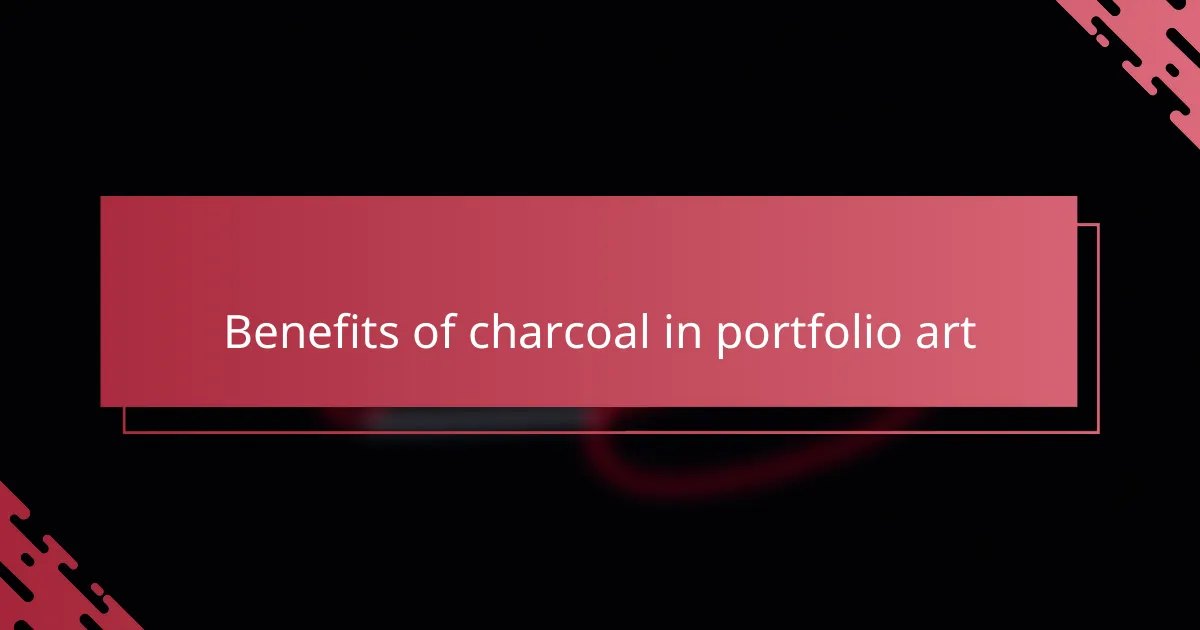
Benefits of charcoal in portfolio art
Charcoal brings a unique depth to portfolio art that digital media often struggles to match. When I include charcoal sketches in my portfolio, I notice how the rich blacks and soft grays create a mood that feels immediate and tactile. Have you ever seen a charcoal drawing up close? The subtle textures and unpredictable shading make each piece feel alive, which really helps my work stand out.
Using charcoal has also sharpened my ability to convey emotion with fewer lines. There’s something about the way a single charcoal stroke can be both bold and delicate that taught me to be more intentional. I remember a portrait I did where the smudged shadows around the eyes gave it a haunting quality I couldn’t achieve with a tablet—those emotional details speak volumes in a portfolio.
Another benefit I’ve found is that charcoal invites experimentation in a fairly forgiving way. While you can’t exactly undo a mark, blending and layering charcoal allows you to explore different tones and effects right on the paper. This hands-on interaction keeps my creative process fluid and spontaneous, which often leads to unexpected, exciting results that I’m proud to showcase.
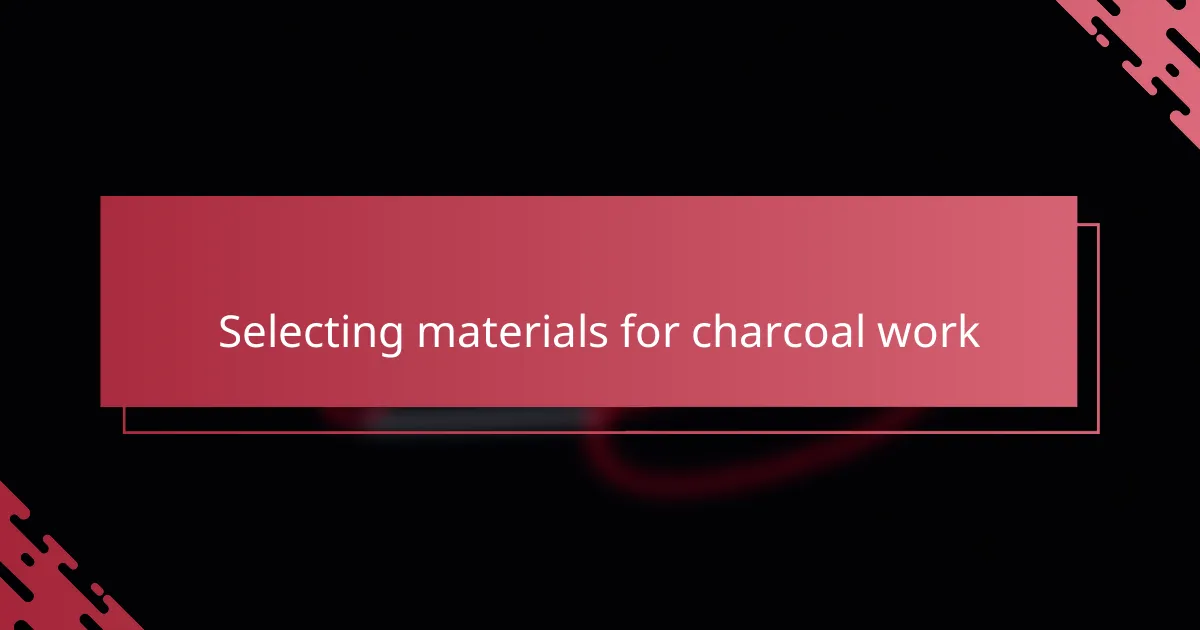
Selecting materials for charcoal work
Choosing the right materials for charcoal work was a bit of trial and error for me. I quickly realized that not all papers are created equal—some felt too smooth, making it difficult to layer the charcoal, while others were textured just enough to grab the pigment beautifully. Have you ever struggled to get a charcoal drawing to hold its depth? For me, using a medium-tooth paper became a game-changer in achieving those rich, velvety blacks.
The charcoal sticks themselves vary a lot too. Soft charcoal gives this buttery feel that’s perfect for dramatic shading, but it’s messier and harder to control. On the other hand, harder charcoal allows for fine details but requires more patience. I found myself switching between the two constantly, depending on the mood I wanted to create. It’s almost like having different voices in a conversation—each tool adds its own nuance.
I also can’t overlook the importance of fixatives and blending tools. Early on, I was frustrated when my drawings smudged with the slightest touch. Spraying a fixative lightly really helped preserve the integrity of my work without dulling the charcoal’s rich texture. And using blending stumps became second nature—they helped me soften edges and build gradual transitions, which digital brushes often try to mimic but never quite match. Have you tried blending stumps yet? They’re simple but incredibly effective in bringing charcoal pieces to life.
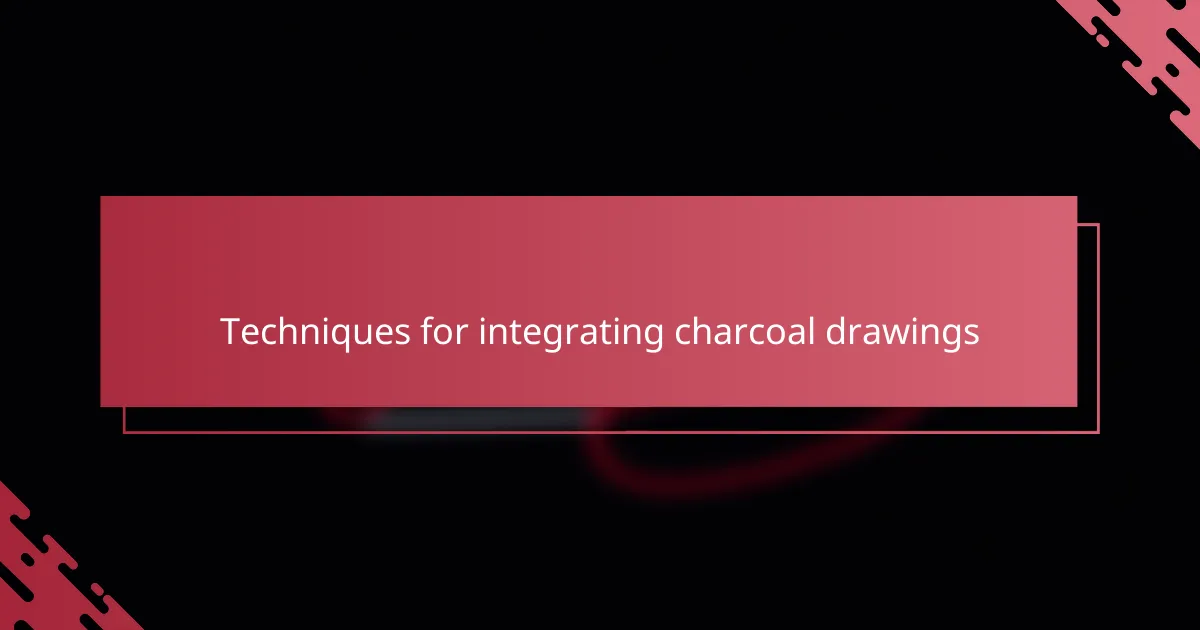
Techniques for integrating charcoal drawings
Integrating charcoal drawings into mixed-media illustrations took some experimentation for me. I discovered that layering digital color washes over scanned charcoal sketches adds vibrancy without losing the charcoal’s raw texture. Have you ever tried preserving that gritty feel while working digitally? It’s a delicate balance, but when done right, it breathes a unique life into the artwork.
Another technique that worked well involved combining charcoal with white gel pens or acrylic highlights. The sharp contrast between charcoal’s softness and the crispness of white lines created depth and focus points that pulled the viewer in. I found this was especially effective for emphasizing light sources or textures that otherwise got lost in the shadows.
Finally, using charcoal’s natural smudging as a background texture helped me integrate it seamlessly with cleaner digital elements. By selectively blurring some charcoal areas and keeping others sharp, I created a sense of movement and atmosphere. This interplay between controlled detail and organic messiness felt like telling a visual story, with charcoal adding the emotional undercurrent beneath the polished surface.
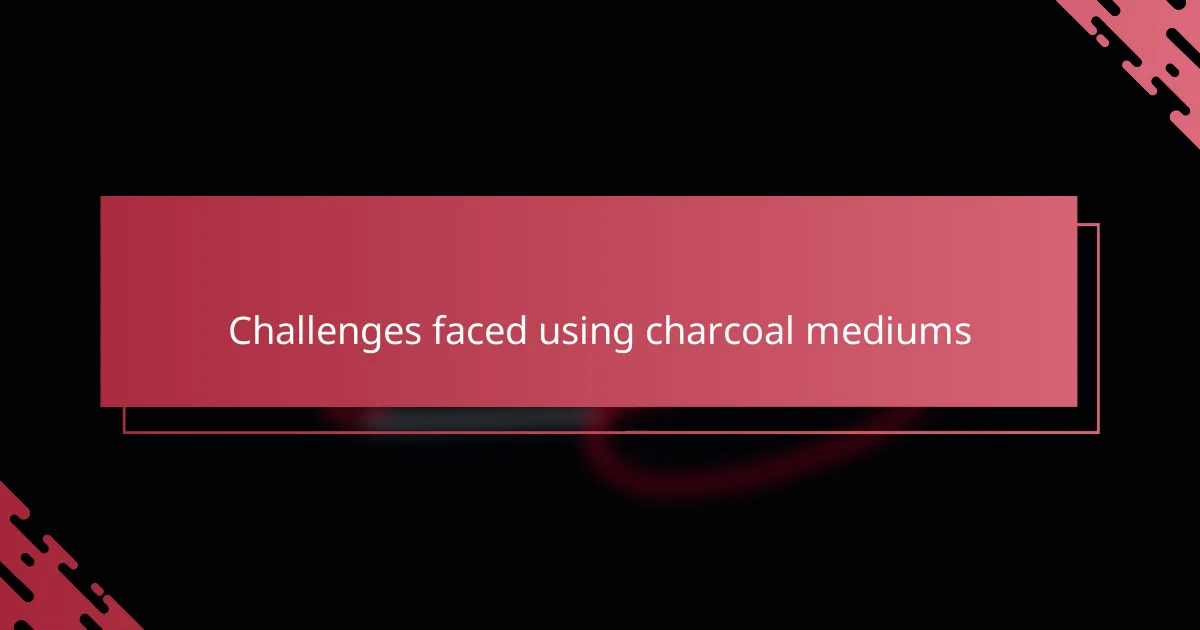
Challenges faced using charcoal mediums
When I first started working with charcoal, controlling the mess was a real challenge. Have you ever felt frustrated watching your hands and workspace get coated in that fine, stubborn dust? I quickly learned that embracing the medium’s messiness instead of fighting it was part of the journey—though I still sometimes catch charcoal smudges where I least expect them.
Another challenge was mastering precision. Unlike digital tools where you can zoom in or undo a stroke, charcoal demands a different kind of focus. I remember struggling to create fine details without everything turning into a blur; blending would sometimes go too far, erasing the crispness I wanted. It took patience and a lot of practice to get comfortable with that balance between bold marks and delicate shading.
Lastly, I often wrestled with preserving the integrity of my finished pieces. Charcoal’s vulnerability to smudging means that even the slightest brush against the paper can alter the drawing. Early on, I ruined several efforts by handling them too quickly or without fixative. Have you ever wondered how artists keep their charcoal work looking pristine? For me, it became an essential step to use fixatives carefully, which felt like both a relief and a new responsibility in safeguarding my art.
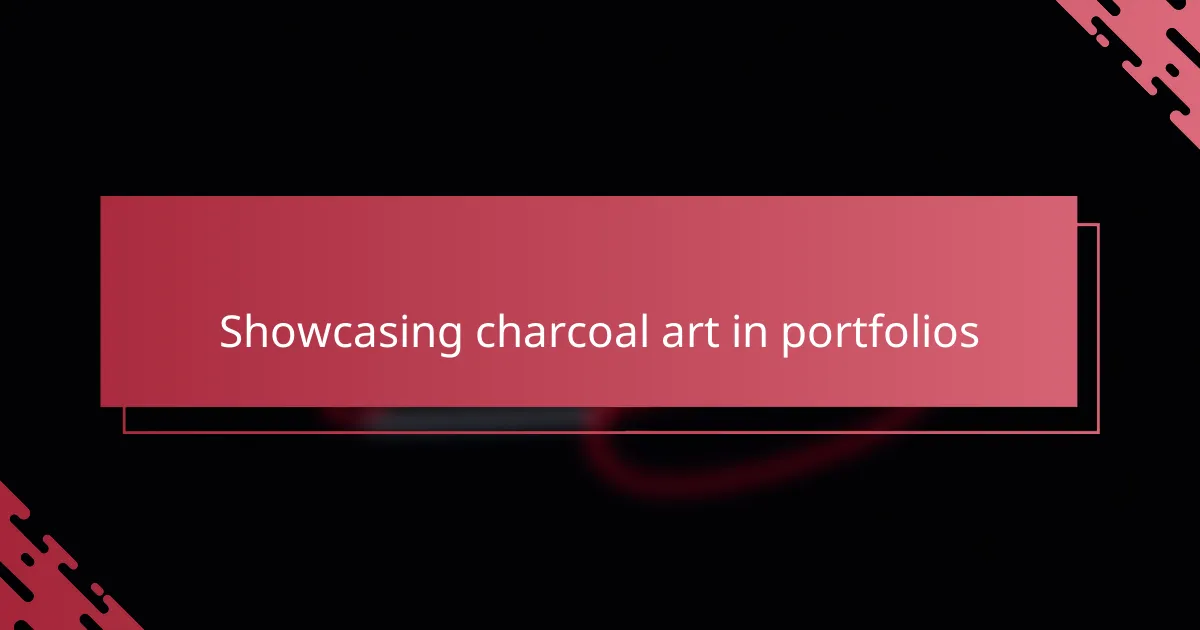
Showcasing charcoal art in portfolios
Showcasing charcoal art in portfolios has always felt like sharing a piece of my creative soul. Do you know how those deep blacks and soft smudges immediately set a tone that digital art can only hint at? When I first displayed my charcoal sketches alongside digital pieces, it was clear they brought a tactile intimacy that grabbed attention and sparked conversations.
I often get asked how to present charcoal work without losing its texture or emotion. For me, high-quality scans that preserve the grain and subtle shading are key, but nothing beats including a few original pieces or prints with a matte finish. There’s something about seeing the uneven strokes and faint dust that tells a story about the artist’s hand and process—details that digital reproductions sometimes flatten.
One of my proudest moments was when a client specifically pointed out a charcoal portrait in my portfolio as “more alive than any other.” That feedback affirmed my belief that traditional media like charcoal, when showcased thoughtfully, adds a depth and authenticity that resonates deeply. Have you tried highlighting these unique qualities in your own portfolio? It might just be the edge that sets your work apart.
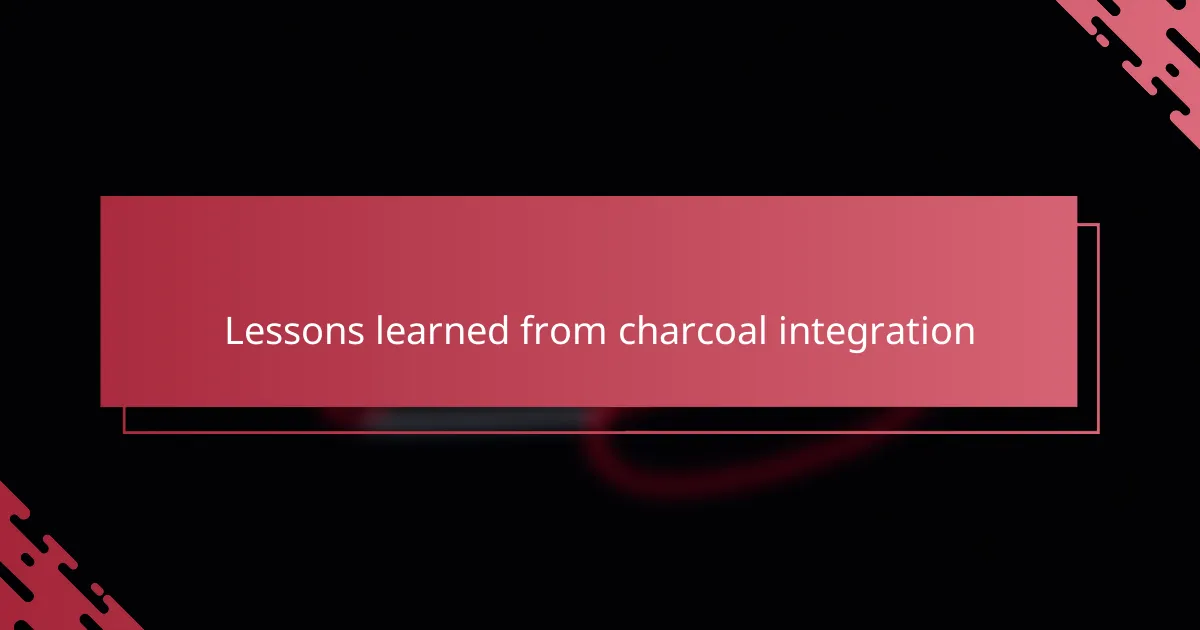
Lessons learned from charcoal integration
Working with charcoal taught me that patience isn’t just a virtue—it’s a necessity. Have you ever felt the pressure when that smudge might ruin your entire drawing? I learned to slow down, accept imperfections, and even welcome them as part of the piece’s story. This shift transformed how I approach all my work, reminding me that art often thrives in its little flaws.
Another lesson that stuck with me is the power of texture in storytelling. Charcoal’s unpredictable smudges and bold strokes bring a raw emotion that’s hard to fake digitally. When I layered charcoal with digital color, I realized how this imperfect texture added depth and feeling that no computer brush could mimic. It made me appreciate how traditional media can push my creativity further, not just complement it.
Finally, mastering charcoal was a humbling experience about control and letting go. At times, I craved precision but had to surrender to the medium’s organic nature. Have you ever struggled between wanting exact lines and the messy beauty of charcoal? Finding that balance taught me more than technique—it taught me to trust the process and embrace the unexpected outcomes that make each piece unique.
